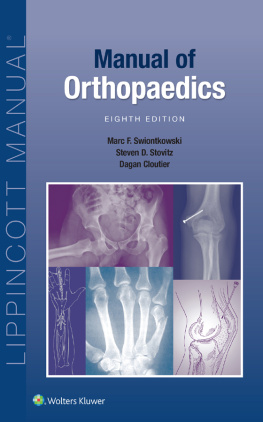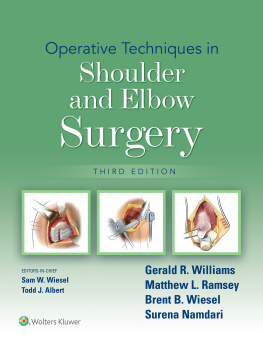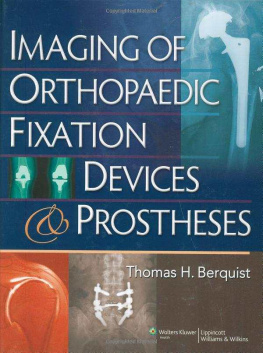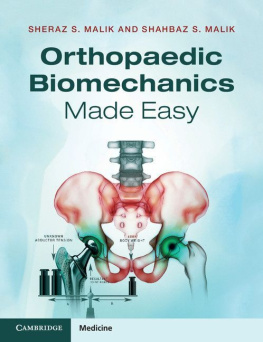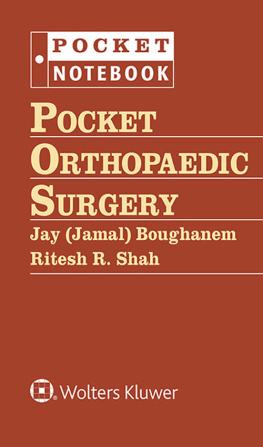
Director, Medical Practice: Brian Brown
Senior Development Editor: Stacey Sebring
Editorial Coordinator: Louis Manoharan
Marketing Manager: Kirsten Watrud
Production Project Manager: Sadie Buckallew
Design Coordinator: Stephen Druding
Manufacturing Coordinator: Beth Welsh
Prepress Vendor: S4Carlisle Publishing Services
Eighth edition
Copyright 2022 Wolters Kluwer.
All rights reserved. This book is protected by copyright. No part of this book may be reproduced or transmitted in any form or by any means, including as photocopies or scanned-in or other electronic copies, or utilized by any information storage and retrieval system without written permission from the copyright owner, except for brief quotations embodied in critical articles and reviews. Materials appearing in this book prepared by individuals as part of their official duties as U.S. government employees are not covered by the above-mentioned copyright. To request permission, please contact Wolters Kluwer at Two Commerce Square, 2001 Market Street, Philadelphia, PA 19103, via email at (products and services).
10 9 8 7 6 5 4 3 2 1
Library of Congress Cataloging-in-Publication Data
ISBN-13: 978-1-9751-4335-0
ISBN-10: 1-975143-35-3
Library of Congress Control Number: 2020947464
This work is provided as is, and the publisher disclaims any and all warranties, express or implied, including any warranties as to accuracy, comprehensiveness, or currency of the content of this work.
This work is no substitute for individual patient assessment based upon healthcare professionals examination of each patient and consideration of, among other things, age, weight, gender, current or prior medical conditions, medication history, laboratory data and other factors unique to the patient. The publisher does not provide medical advice or guidance and this work is merely a reference tool. Healthcare professionals, and not the publisher, are solely responsible for the use of this work including all medical judgments and for any resulting diagnosis and treatments.
Given continuous, rapid advances in medical science and health information, independent professional verification of medical diagnoses, indications, appropriate pharmaceutical selections and dosages, and treatment options should be made and healthcare professionals should consult a variety of sources. When prescribing medication, healthcare professionals are advised to consult the product information sheet (the manufacturers package insert) accompanying each drug to verify, among other things, conditions of use, warnings and side effects and identify any changes in dosage schedule or contraindications, particularly if the medication to be administered is new, infrequently used or has a narrow therapeutic range. To the maximum extent permitted under applicable law, no responsibility is assumed by the publisher for any injury and/or damage to persons or property, as a matter of products liability, negligence law or otherwise, or from any reference to or use by any person of this work.
Shop.lww.com
The eighth edition of the Manual of Orthopaedics further expands the conversion of the manual from one focused on medical students and orthopaedic surgery junior residents to adding the audience of emergency room providers, urgent care providers, primary care providers, and now physician assistants and nurse practitioners (PAs/NPs) practicing in musculoskeletal care centers. This is the fourth edition to use this title, which was changed from the original title of Manual of Acute Orthopaedic Therapeutics. The title change started the evolution toward the broader audience, which is now complete. This introduction will conclude with a list of new features in the eighth edition. It remains a worthwhile task to review the history of this useful spiral notebook to place the continuing changes within the context of the evolution of musculoskeletal care.
The Manual of Acute Orthopaedic Therapeutics was the creation of Dr. Larry Iversen, who worked out its basic framework and conceptualization with his orthopaedic mentor, Dr. D. Kay Clawson. Dr. Iversen was at the time a senior resident working closely with Dr. Clawson, who was the first professor and chairman of the Department of Orthopaedic Surgery at the University of Washington. The orthopaedic services at the University Hospital and King County Hospital (later renamed Harborview Medical Center) were active and focused mainly around the management of injured patients. Drs. Clawson and Iversen saw the need for a manual that would improve education and patient care in these institutions. Those were days when the management of long bone fractures was in transition from traction and casting to surgical techniques, and the University of Washington Orthopaedic department was at the forefront with wonderful, dedicated, and creative clinicians like Drs. Robert Smith and Sigvard Hansen. In those times, care was primarily delivered by junior house staff, interns, and medical students, and they needed information readily at hand. Therefore, the manual provided the how-tos for traction, casting, and pre- and postoperative care while explaining the rationale for treatment decisions and providing an excellent reference list for later review and in-depth study. This manual was a labor of love for Drs. Iversen and Clawson; the two would often work on the manuscripts for three straight weeks seated around the dining room table in Dr. Clawsons home. Little Brown publishers liked the concept of the book and added it to its growing list of subspecialty spiral manuals; the book enjoyed broad acceptance.
Each of the first three editions brought a review of the contents and reference list for each chapter as the field continued to evolve. In 1987, I returned to the University of Washington, where I had done my training (and used the second edition), to assume a position at Harborview Medical Center. In 1991, I was a new professor in the department and chief of the orthopaedic service, and Dr. Clawson asked me to assume his place with the manual. It was then Dr. Iversen and I who labored for 2 weeks in the medical school library revising the chapters, updating the reference lists, adding sections of historical references, changing several illustrations, and adding fresh chapters on infection and rheumatologic conditions. As such we began to broaden the scope of the manual to include conditions that were nonacute and nontrauma related in order to make the manual more useful for students and interns as well as to provide a more comprehensive tool for primary care physicians. The changes in care delivery moved strongly in favor of attending delivered/supervised care in academic centers where the manual was in widespread use. As such the chapters evolved drastically as the push toward surgical management of fractures had dramatically changed the way trauma patients were managedfor the better, we believe.
For the fifth edition, Dr. Iversen, with a mature, busy private practice in Bremerton, Washington, chose to step aside. I moved from the University of Washington to assume the chair of the Orthopaedic Surgery Department at the University of Minnesota in 1997 and brought the project along. This was the point where we made a major philosophical shift in the manual, changing its title to the Manual of Orthopaedics. It became a more comprehensive tool, covering nearly all areas of orthopaedic surgery in new chapters. Members of the Department of Orthopaedic Surgery at the University of Minnesota agreed to support the project by authoring new chapters on pediatric orthopaedics, nontraumatic hand and shoulder surgery, spine, and chronic and nonacute lower extremity orthopaedics. Treatment protocols preferred by the attending staff at Hennepin County Medical Center, where the University of Minnesota has a level 1 trauma rotation, were added. These were placed at the end of appropriate chapters, and the intent was to provide a set of principles for decision making, which serve as a starting point for developing individualized treatment plans for patients. The manual at that time moved from a two-author project to a multiauthor, single orthopaedic surgery department project in the evolution toward greater usefulness for students, house staff, and primary care physicians.

